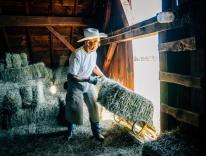
Jackson Pollock, One: Number 31 (1950)
From a distance, the surface of the first painting displayed in the Museum of Modern Art’s exhibit on Abstract Expressionism seems like an intricate and confusing web. On closer inspection, however, an extraordinary clarity is evident, and the beauty and complexity of the poured and dripped paint hits the viewer with full force. Lines of silver, white, and black crisscross each other as tiny fragments of red, yellow, and blue appear throughout, above and below the rhythmic lines; the handprints in purple and red—on the upper right, the lower left—seem to extend the raw canvas beyond the confines of its physical shape. The entire painting, Jackson Pollock’s Number 1A, 1948, is a visual syncopation comparable to an ecstatic Gregorian chant or a solo by John Coltrane. It is one of the many extraordinary pictures in “Abstract Expressionist New York” (on view at MoMA through April 25), an exhibition that extends over three floors and consists of hundreds of paintings, works on paper, sculptures, and photographs. All the work is drawn from the museum’s extraordinary permanent collection.
The term “abstract expressionism” was first used in a review in the New Yorker in 1946; since then it has come to describe a self-consciously American style of art that emerged in New York City during the late 1940s and dominated the international art world until the late ’50s. The basic identifiable elements of abstract expressionism are monumental scale, freely scribbled brush marks or bleeding veils of color, and abstract imagery. What made the style so “American”? Partly its eclecticism. These artists were eager to absorb all kinds of earlier styles (cubism, surrealism, Mexican mural painting) and transform them into something new and bold, the visual equivalent of bebop jazz and the free-verse poetry of the beat generation. The variety of work produced transformed modern American art from a provincial to an international phenomenon, replacing Paris with New York as the capital of modernism until the 1980s. The reasons for this shift from the “old world” to the “new” were varied: the destruction and exhaustion of postwar Europe, the rise of the United States as an economic and political superpower, and the anemic state of French painting after 1945.
Unfortunately, only the photographs and a handful of paintings, drawings, and sculpture work well in what is finally a visually exhausting, almost haphazard show. The installation of the pieces is too crowded, and there are many awkward arrangements between painting and sculpture. The exhibit’s curators offer no new or persuasive narrative commentary explaining how the show holds together as a whole. There are, however, exceptional individual works on display. Pollock’s Full Fathom Five, One, and Number 1A, 1948 can be seen as a summation of modern painting from Turner to Seurat, from surrealism to the Mexican muralists. Pollock was a synthesizer on a notoriously grand scale, using painterly gesture and color, shallow space and calligraphic structure, in unprecedented ways. The controlled chaos of his paintings communicate a new “American” energy, in both its positive and negative aspects.

Mark Rothko, No. 16 (Red, Brown, and Black) (1958)
Alongside Pollock, exhibitgoers are treated to the pictorial power of Arshile Gorky, Willem de Kooning, Mark Rothko, Ad Reinhardt, and Philip Guston. Two small, jewel-like pictures by Norman Lewis (the only African-American artist associated with abstract expressionism) demonstrate how monumentality can be achieved on a canvas of no more than thirty inches. It was disappointing to find only one painting each by Grace Hartigan and Joan Mitchell. These two Irish-American artists were gutsy women whose brightly colored paintings and vigorous drawings outshine in quality and consistency many of their male peers. Mostly forgotten yet wonderful painters like William Baziotes and Bradley Walker Tomlin (with an intensely green homage to Gertrude Stein) hold their own. Less satisfying are the dry and minimal paintings of Barnett Newman and Adolph Gottlieb. A tiny side gallery—which seems like an afterthought—contains some amazing photographs, both delicate and rough, especially those of Harry Callahan and Frederick Sommer. Among the sculptors, Isamu Noguchi, Louise Nevelson, and Louise Bourgeois are represented by elegant pieces that in their freshness seem as if they were carved and assembled yesterday.
Decades ago the art critic Irving Sandler published The Triumph of American Painting, one of the first books on abstract expressionism. Looking back, the title and thesis appear to reflect a certain kind of American arrogance, even ignorance. More than fifty years later, the lasting achievements as well as the hollow failures of American art at the beginning of the Cold War can be seen more clearly. When Pollock, Mitchell, Rothko, and Nevelson did their best work, they were acting against the materialism, alienation, and sometimes hysterical anti-Communist politics of Eisenhower’s America. A metaphysical hunger and spiritual questioning, so at odds with the complacency of much postwar American culture, is evident in their works. One of the last paintings in the exhibition is a figurative oil by Philip Guston, done toward the end of his career, when he had abandoned abstraction. It depicts hooded, cartoonish figures, riding an old jalopy on an otherwise empty road, set against an apocalyptic backdrop: a metaphor for the artist’s sense that American exceptionalism in politics and art had reached a deflating endpoint. The pop art of the 1960s brought back the human figure to American painting, even if charged with irony and often disassembled into a consumer object. The decade that followed the “triumph” of abstract expressionism ushered in twenty years of turmoil and radical change: the first (and only) Roman Catholic president, civil rights and the Vietnam War, assassinations and feminism at home, and revolutionary movements across the globe. Americans, and American art, would never be the same.
